Box Turtles are omnivores and require a wide variety of plants and meat in their diet.
For any turtle, a healthy diet is key to having a long and happy life.
The most common mistake owners make is feeding too much or too little of one nutrient. A Box Turtle’s diet is one of the most difficult aspects of their care.
These reptiles require a healthy balance of protein, carbohydrates, vitamins, minerals, water, and fats.
Keep reading below to learn exactly what to feed a box turtle, when to feed them and how much…
What Do Box Turtles Eat?
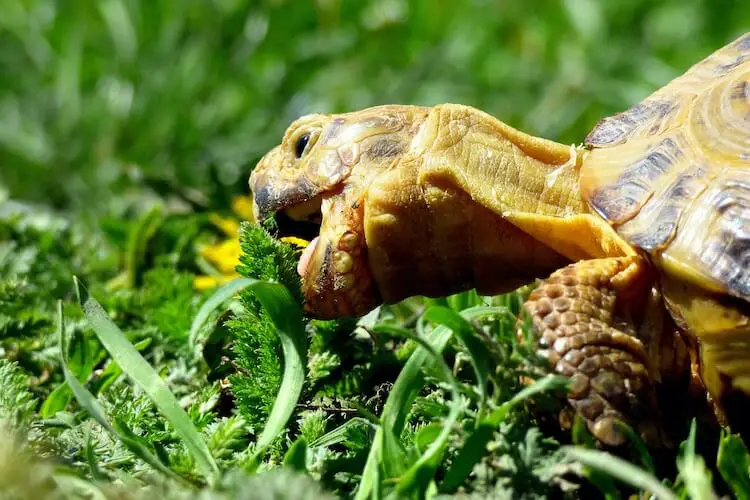
Box Turtles are omnivores and so should eat a wide variety of plants and meat in captivity:
- They are mostly carnivorous so over half of their diet should consist of insects, invertebrates and dead animal matter.
- Around 30% of their diet should be vegetable matter such as leafy greens that are full of nutrients.
- The rest of the diet should be various fruits.
They normally find their food by foraging.
Box Turtles actively search for food and will eat most things they find by extending their neck and biting down hard.
Adults eat several times each week.
They enjoy eating mushrooms, insects, earthworms, crayfish, gastropods, myriapods, frogs, carrion, slugs, snails, and other dead animal matter.
In the wild they will also eat many wild versions of fruits you may find in your home. Good examples include mayapples, elderberries, blueberries, strawberries, black cherries and frost grapes.
Because of their varied eating habits, in captivity you should feed as much variety as possible.
It may take a couple months to find their favorite foods. Generally most of a box turtle’s diet should be animal matter. This can include anything from dog food to crickets, however, they generally like live insects and worms.
The rest of their diet should be mostly leafy greens and some fruits.
Box Turtle Diet
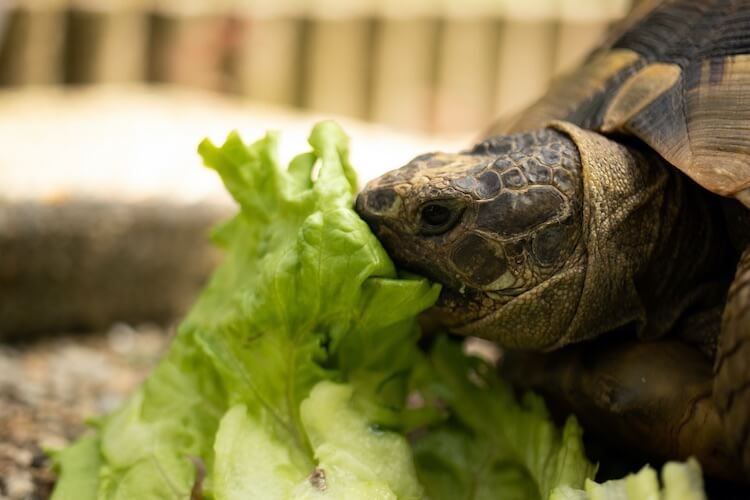
Diet is one of the most important husbandry factors for Turtles.
Many illnesses and diseases are caused by either poor husbandry or diet. This can be a lack of food, too much food, a nutrient deficiency or an excessive amount of nutrients.
Box turtles that are not fed a variety of foods often have an unbalanced diet and lack vitamins or minerals – often calcium or vitamin A.
Most feeding mistakes are easy to avoid.
Adult Diet
| Fruit | Vegetable | Leafy Green | Protein | |
|---|---|---|---|---|
| Sunday | Single, diced strawberry | 1x tbsp mixed veggies | 1½x tbsp collard greens and kale | 3x earthworms |
| Monday | 3x blueberries | |||
| Tuesday | Melon rind and diced melon | Chopped green beans | Dandelion leaves and watercress | Crickets, 1x tbsp of soaked dry dog food |
| Wednesday | – | |||
| Thursday | Single, diced strawberry | 1x tbsp mixed veggies | 1½x tbsp collard greens and kale | 3x earthworms |
| Friday | – | |||
| Saturday | Melon rind | A few peas in the pod | Dandelion leaves and watercress | Crickets, 1x tbsp of soaked dry dog food |
Adults need to eat a wide variety of foods in captivity. Feeding a box turtle is more difficult than other reptiles because of the variety of foods they require.
You should aim to feed a diet that consists of 60% meat, 30% vegetable and 10% fruit. Some good meat sources include:
- Dog Food (Semi-Moist, Canned, or Soaked Dry Food)
- Whole Skinned Chopped Mice
- Baby Pinky Mice
- A Goldfish
- Soaked Trout Chow
- Monkey Chow Biscuit
- Earthworm
- Crickets
- Waxworms
- Mealworm
- Silk Moth Larvae
- Sardine
- Slugs
- Grasshopper
- Slugs,
- Raw or Cooked Meat
You should not feed all of these meats, but you should feed at least three or four. Dog food and monkey chow should make up less than 5% of your turtle’s diet.
If you feed insects then dust them with calcium carbonate, lactate, or gluconate.
For the rest of the diet aim to feed mostly vegetables and some fruit.
Fruits are very tasty for most turtles, but unfortunately they are not as nutritional as vegetables and should be fed in moderation.
Feeding a balanced diet is easy when you make a salad.
A salad should consist of a meat source (any from the list above), two types of leafy greens, thawed frozen mixed vegetables and one fruit. Wash fruits and vegetables thoroughly, chop them into bite-sized pieces and dust the salad with a multivitamin twice a month.
Prepare a salad at the beginning of every week and refrigerate it.
Offer it to fully grown adults every other day and refrigerate any leftovers.
Baby Box Turtle Diet
| Fruit | Vegetable | Leafy Green | Protein | |
|---|---|---|---|---|
| Sunday | Chopped raspberries | Mixed Veggies, ½ of a romaine lettuce leaf | Escarole | Sardines |
| Monday | Chopped raspberries, small orange slice | Mixed veggies | Escarole | crickets |
| Tuesday | Chopped raspberries | Mixed veggies | Escarole, kale | Sardines |
| Wednesday | Chopped raspberries | Mixed veggies, ½ of a romaine lettuce leaf | Escarole, beet tops | Crickets |
| Thursday | Sour cherries | Chopped sweet potatoes and bell peppers | Turnip tops, spinach |
Mealworms |
| Friday | Sour cherries | Chopped sweet potatoes and bell peppers | Turnip tops | Mealworms |
| Saturday | Sour cherries | Chopped sweet potatoes and bell peppers | Turnip tops | Mealworms |
Baby box turtles have a very similar diet to adults – however they can be picky eaters and should be fed everyday.
They should eat the same salad as adults, but need it chopped into smaller pieces.
Getting your baby turtle to eat a healthy salad-mix can sometimes be difficult. The key is patience, persistence and sticking to providing a healthy diet.
Don’t overfeed fruits to a baby. It is almost guaranteed this will be their favorite delicacy. Keep feeding meats and vegetables even if they reject these foods at first.
Try using different meats and greens to find their favorites.
It may take several weeks for your baby to adjust to a healthy diet. However, it is better for their health in the long run.
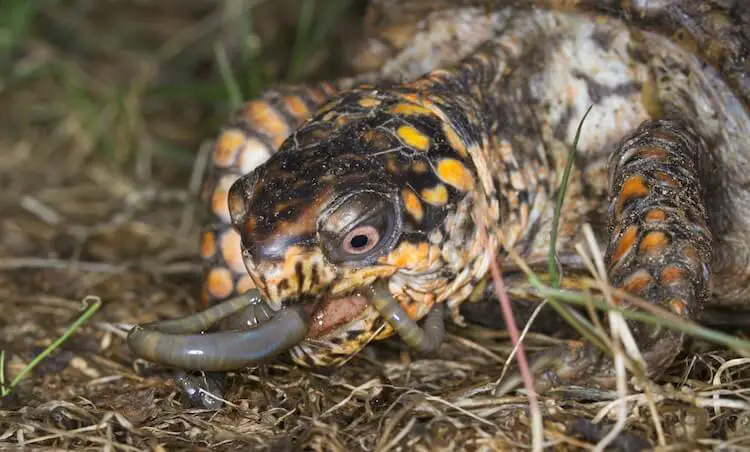
Can Box Turtles Eat:
Apples: Yes. But they may not enjoy them as much as other fruits. Apples should be cut into small pieces before feeding.
Bananas: Yes. Bananas are commonly fed, but most turtles do not enjoy them as much as melons or berries.
Blueberries: Yes. They are safe to feed as a snack. Blueberries are not as common as other berry fruits.
Cabbage: Yes in moderation. It can cause thyroid issues if fed in high amounts.
Carrots: Yes. Carrots are nutritional and can be fed alongside leafy greens. Box turtles tend to like brightly colored red, orange and yellow vegetables.
Celery: Yes. But, like cucumbers they do not supply many nutrients.
Cucumbers: Yes cucumbers are safe to feed.
Grapes: Yes. Grapes are palatable and nutritious. They can be fed with your turtle’s salad or as an infrequent treat.
Green beans: Yes. They often come in mixed vegetable bags.
Lettuce: Yes. Lettuce is very healthy for your box turtle to eat. It has little nutritional value and should be supplemented with bright vegetables and dark greens.
Oranges: Yes. Your turtle may be disinterested in eating them, but they are still safe in their diet. Oranges are a citrus and may be sour.
Spinach: Yes in moderation. Spinach is packed with nutrients but contains calcium binders.
Tomatoes: Yes. Tomatoes are safe to feed and can be fed with a meal or as a small snack.
Watermelon: Yes. The fleshy fruit and rind is healthy for your turtle to eat. For most this is their favorite fruit.
What Fruit Can Box Turtles Eat?
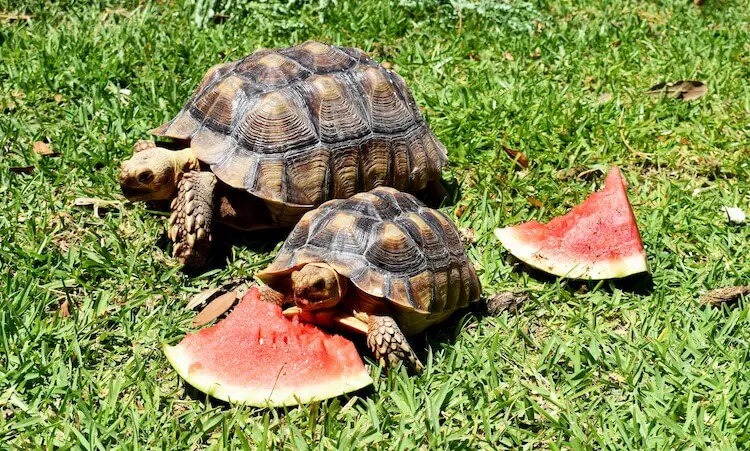
Fruit should be fed to your box turtle in moderation. It should only make up 10% of their diet and serve as a tasty treat.
Their fruit intake should be limited to once a week, and you should try alternating the type of fruit every few weeks.
See the list below for the different fruits your box turtle can eat:
| Safe Fruits To Feed | ||
|---|---|---|
|
|
|
What Vegetables Can Box Turtles Eat?
Most vegetables are safe to feed your turtle.
Plants and vegetables should make up 30% of their diet.
You should only feed the most nutritious plants such as dark, leafy greens. See below for a full list:
| Safe Vegetables To Feed | ||
|---|---|---|
|
|
|
What Can’t Box Turtles Eat?
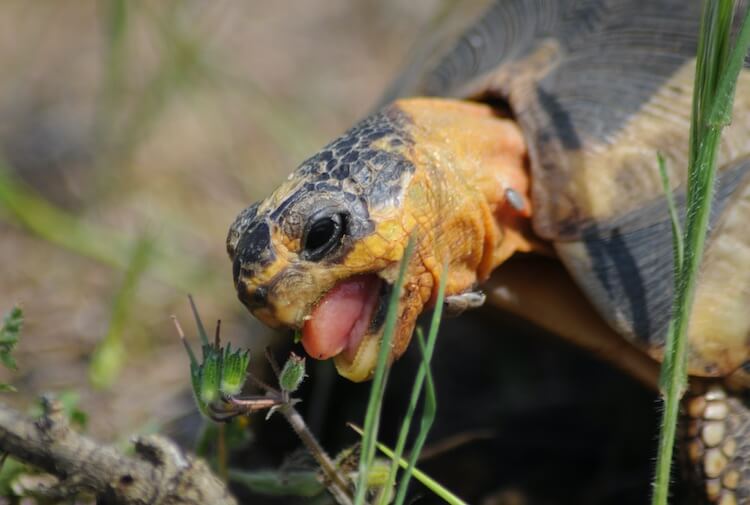
A good rule of thumb is “do not feed your box turtle anything they would not find in the wild”. Good examples of foods to avoid include dairy products, processed meats, candy, bread and other baked goods.
In the wild Box Turtles eat anything they can find.
However there are some foods they would not find in the wild, and should not be fed in captivity:
- Bread
- Baked Goods
- Candy (Chocolate, Taffy, Hard Candies)
- Cat Food
- Dairy Products
- Poison Ivy
- Potato Leaves
- Processed Foods
- Rhubarb
- Substrate
- Tobacco Plants
- Tomato Leaves
Rhubarb is toxic to box turtles and should never be fed. Other toxic plants include potato and tobacco leaves, avocado plants, poison ivy, and the leaves of tomato plants.
Dog food fed in moderation is perfectly fine. However cat food is too high in protein, fat, and vitamin D for turtles as cats are strictly carnivorous.
Common Feeding Mistakes
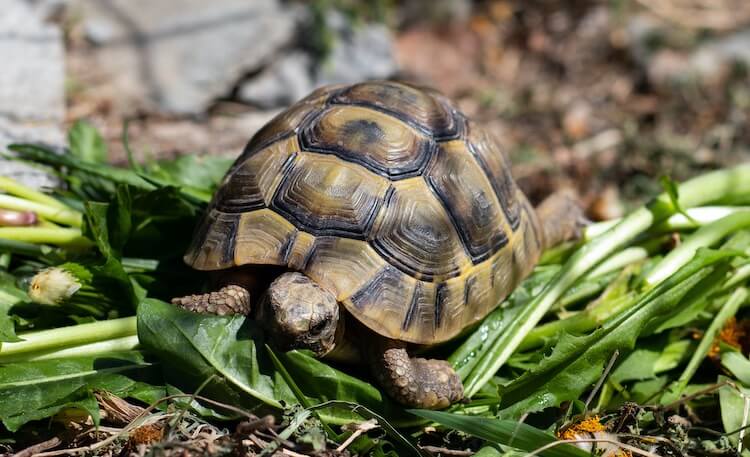
Feeding mistakes are very common with first time reptile owners.
Many of these mistakes can be detrimental to your pet’s health and can drastically decrease their lifespan. Luckily these mistakes can be avoided with practice, knowledge, and a consistent husbandry routine.
A common mistake is feeding too little or too much vitamin A.
Abnormal levels of vitamin A can lead to your turtle being underweight and malnourished. This disease can be prevented by feeding vitamin A rich foods such as carrots, sweet potatoes, butternut and winter squashes, liver, dandelion greens, spinach, and turnip and mustard greens.
Starvation is another common problem with this reptile – especially winter anorexia.
Your turtle will feel lighter and could be severely dehydrated too. Soaking your turtle overnight is a good way to rehydrate them. To keep your turtle well-fed during the winter months, feed a balanced and nutritious diet.
Finally, metabolic bone disease is a very common illness among reptiles. It usually results from a lack of calcium in the diet.
This problem can be easily avoided by dusting your turtle’s salad with a calcium supplement twice a month.
Conclusion
Feeding a baby box turtle will take patience and a consistent husbandry routine.
Adults should eat about three times each week and babies should eat every day.
A box turtle’s diet should consist of meat, leafy greens and fruits in a ratio of 60:30:10. Ideally feed a homemade salad with a meat source (e.g. crickets, worms or insects) two types of leafy greens, thawed frozen mixed vegetables and one fruit.
They are fun and interesting pet reptiles that can live for a long time with a balanced diet and correct husbandry. Do you have any feeding tips? Tell us below!


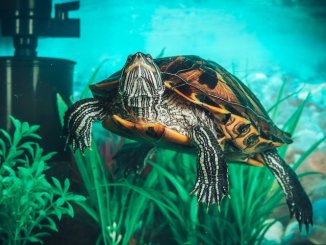
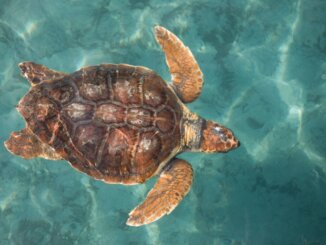

I have a baby box turtle I rescued as a wild hatchling from a flooded area. She is 10 months old now and actually hibernated most of the Florida winter even tho she was kept inside. She seemed to respond to outside temps more than inside. While hibernating she did not eat or drink. She is just now accepting food other than live mealworms mostly tomato and raw squashes no leafy greens.
Box turtles are omnivores, they will eat animals like insects as well as plant based foods. They thrive on animal protein, fruits, vegetables, and other greens. You can grow edible water plants.
Animal protein: snails, crickets, slugs. You may want to try turtle pellets and low fat cat food for protein (50% of the diet should be protein for turtle babies).
Fruits: tomatoes are great, try apples, peaches and cut grapes too.
Vegetables: Veggies rich in Vitamin A are great so squash was a good choice. Try shredded carrots and sweet potatoes, green beans (raw) and cucumber. Lettuce of all varieties are a great addition too.
Vegetation: Dandelions, clover, leafy weeds, edible aquatic water plants like water lettuce and duckweed that you can grow by yourself. Never give your box turtle fruits or vegetables that have been sprayed with pesticides or herbicides without washing them off in soap and water.
Once your turtle becomes a juvenile, you can reduce feedings from daily to two to three times per week.
Feed your turtle mid morning after she has had a chance to warm up. Place the food on a tile or shallow dish so they can easily get to it. Try moving the plate to a secluded location as some turtles like to eat alone.
Don’t feed her with big chunks pea size food is better and gradually increase the size as she grows. Give her a variety of food and like most “kids”, keep trying stuff she would not eat a week or even a month ago.
I have 3 female and 3 male desert ornate turtles. I have kept them separated for almost 2 years. I had a surprise baby emerge about 2 weeks ago. I her in a large container to separate her. She hunted a worm and ate the tip of it several days ago. She hasn’t been interested in eating anything since. It’s been at least 5 days. I am trying different things, but she is not interested and just hides. Anyone have advice? Appreciate it!
Hi did you get her to eat? I rescued a baby box turtle about a week ago, she has to not even be a month old yet, maybe just about. She won’t eat any fruits or veggies I give her. She has only eaten live worms from the backyard so far! Tried to give her some meal worms but she didn’t even eat that. It seems like she’s not going to eat anything that isn’t alive & moving.. ugh. Do you have any tips?! I want her to have a healthy, balanced diet 🙁 thank you!
Feeding a baby Box turtle is like feeding any new baby. It takes time, patience, and consistency. She should have a diet of 50% protein, 25% fruit, and 25% vegetation. (although some sources quote 60:30:10 ratio at first). Food needs to be varied. Like most “kids”, keep trying new things. What did not work a week ago might work today.
They are mostly carnivores, so try insects, invertebrates, and dead animal matter. They need calcium and Vitamin A. Some protein sources can be sardines, crickets, mealworms, and available insects.
Fruits can range from berries, grapes, strawberries, bananas, even apples, and oranges. Veggies high in vitamin A is carrots, pumpkin, sweet potato (raw),
Feed your turtle mid-morning after she has a chance to warm up. Place the food on a tile or shallow dish so they can easily get to it. Try moving the plate to a secluded location as some turtles like to eat alone.
Don’t feed her with big chunks pea-size food is better and gradually increase the size as she grows. Veggies rich in Vitamin A are great, so squash was a good choice. Try shredded carrots and sweet potatoes. Green beans (raw) and cucumber. Lettuce of all varieties.
Even though turtles have a hard shell and live a long life, generally, a turtle who stops eating is not a good sign. Small changes in the environment can have a big impact on your pet. It can disrupt their normal bodily functions. There are a number of reasons why a tortoise will stop eating.
Start asking these questions:
Is the temperature correct and consistent? Tortoises are ectothermic or cold-blooded; they produce very little body heat. They need to be kept in the right temperature range for their species. (Generally between 68-80 degrees F. Do they need an extra heat source? Is the ground colder than the air? Desert tortoises like to bask in 90 degrees F.
Has the lighting changed? Tortoises need UVB and UVA light. They need between 10-14 hours of sunlight per day.
Is her feeding dish accessible? Has it been cleaned out daily from rotten food or debris?
Does she need to hibernate? If your environment seems ok, it’s time to check with a Veterinarian.
I find lots of box turtles in my backyard in the spring. When i find them i offer some of my bearded dragon’s kale to them